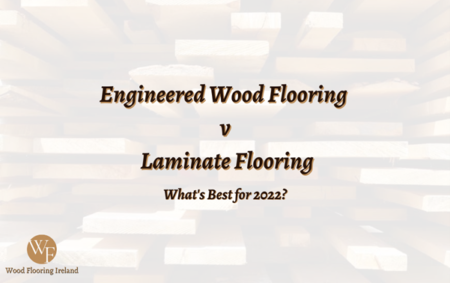15 December 2021
By Roger Kennedy
roger@TheCork.ie
Laminate and engineered wood flooring are most definitely the two most obvious choices if you’re looking for that classic, solid feel but at a more reasonable price.
Whilst both have been developed as a viable economic alternative to solid floors, there are key differences between the two when it comes to things like sustainability, longevity, and overall cost.
The Basics
So, what separates the two? Well laminate flooring is a completely man-made option comprised of a number of layers sandwiched together, complete with a fibreboard base and then a photographic image layer glued to the top, it’s then treated with a transparent layer over the top in order to protect the finish. This practice can leave you with a fairly realistic looking finish, however, generally speaking upon close inspection you can easily tell the difference.
Engineered wood flooring is a different beast however, mainly for the simple reason that it uses real wood. The top layer is made of genuine wood, rather than being a slab of wood the whole way throughout the floorboard the engineered woods are constructed by bonding a layer of true hardwood over what is usually a substrate of super high quality plywood. This gives the flooring a far more malleable group of properties and actually makes it an even better choice than solid hardwood in certain situations.
Water Resistance, Heat Retention
Certain laminates are actually labelled and advertised as ‘water-resistant’ which is a very wishy-washy term. These laminate floors contain an integral, core layer made of fibreboard which can be easily damaged if any water manages to permeate down through the cracks in the floorboards. This can cause serious damage, but in saying this, the plastic top layer is somewhat water-resistant as long as any spills or puddles are mopped up as quick as possible.
On the flip side, the engineered floors are usually finished off with an extremely strong waterproof surface sealant. These floors, due to their rather unique construction can hold their shape far better under prolonged moisture exposure than both laminates and solid hardwoods. Engineered options also have far more dimensional stability, which means they can be installed in more damp areas of the home like a kitchen or bathroom, where previously solid wood floors would struggle and you’d be left with no other options but laminate.
When it comes to heat retention and overall heat resistance, there isn’t a great deal to separate the two, however, both do have great resistance to damage from the sun and heat that comes with it. Engineered wood flooring can also be used in your underfloor heating systems.
Long Lasting or Quick Replacement?
Most people are drawn towards laminates as they are a cheaper option, however, they do not tend to last anywhere near as long as their engineered wood flooring counterparts. Laminates are quite strong due to their compressed layers, which makes them ideal for areas with high footfall, but they cannot be refinished and generally need to be replaced after about 15-25 years.
Engineered wood flooring as a 20+ year life span and can be actually re-sanded and re-finished multiple times, giving it another lease on life. Even the thinnest engineered floor can be sanded down several times which can give it a lifespan of up to 50 years, generally, people gravitate towards a long plank wood flooring option for busy areas in the home, like a hallway or entryway. However, it is absolutely essential to correctly maintain these specialist floors, without proper care they can be left looking tired and beaten far quicker than normal, see this article on how to clean engineered wood floors for more information.
Laminate does hold a big advantage when it comes to day one cost, coming in as one of the cheapest (if not the cheapest) options on the market today. In comparison, the initial cost of the engineered option is greater, but you’re also getting a longer lifespan out of the floor.
You’ve also got to consider things like resale value, generally speaking, laminate flooring tends to actually compromise a homes overall value (although it is still more favourable than carpet) but it will never be viewed in the same light as genuine wood. Engineered wood flooring does offer a greater potential resale value to a home and in some cases may actually be more desirable than solid flooring.
Noise & Comfort
Both of these options are highly comfortable and ideal for any home, but because laminate flooring technically ‘floats’ over the subfloor beneath, it has a tendency to buckle and flex underfoot in certain situations, especially if the underfloor has not been laid smoothly and level. Homeowners with laminates have also tended to note that pet nails and even high heeled shoes click rather annoyingly when they come into contact with the plastic top layer.
The engineered options are usually far thicker and in 90% of situations they are nailed/glued down so there is no fear of flexing. It does have a tendency to feel ‘hard’ underfoot in comparison to laminate as this usually has a foam underlayer beneath, whereas engineered flooring does not.
The Round Up – Sustainability at the Core
If you’re looking for a floor that has all of the major hallmarks of a solid wood floor but without the exorbitant costs, engineered wood flooring is the way to go. It is a far more sustainable, eco-friendly and affordable option. The entire process of creating an engineered wood floor is a far greener option than its laminate counterpart, these are compressed together using toxic glues and are generally packed full of formaldehyde. Engineered floors are even more sustainable than solid wood floors as they obviously use far less of a tree per plank than the solid options.
You’ve also got to consider things like air quality and actual chemical emissions. Wood is a totally carbon neutral entity, which means that is has a very low impact on the environment throughout its lifespan (They’re also hypoallergenic, something that is becoming more and more important in Ireland on a yearly basis) – When searching for an engineered wood floor you should really investigate the VOC levels, these are harmful chemicals that some organisations use in the treatment process. Corks own Wood Flooring Ireland treat their wood with UV Oil but can also treat with lacquers, liming, bleaching, smoking and much more, most importantly these are all VOC and Formaldehyde free.
If you’re looking to change your flooring this year, get in contact with Wood Flooring Ireland, specialists in bespoke, handcrafted wood floors. Located at the Jim Power Industrial Estate on the Tramore Road, the team at WFI have over a decade of experience in the wood flooring business. Whether you’re looking for chevron flooring or herringbone flooring for a bedroom or some stunning Versailles panels for a living area, there’s something for every style and taste.


